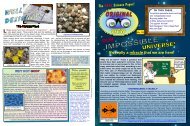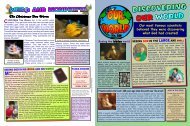CRT-OV-88
CRT-OV-88
CRT-OV-88
You also want an ePaper? Increase the reach of your titles
YUMPU automatically turns print PDFs into web optimized ePapers that Google loves.
YAPOK is another name for the Water Opossum, a marsupial<br />
mammal which lives in Central and South America. They are<br />
the only living aquatic marsupials, and spend much of their lives<br />
swimming in rivers, feeding on crayfish, shrimps and other water<br />
creatures. Yapoks have a number of special design features to suit<br />
their aquatic lifestyle. They have water-proof fur and webbed<br />
hindfeet to aid swimming.<br />
Yapoks build a nest on land, where they<br />
give birth to up to five young, which are<br />
very tiny, being born just 12-14 days after<br />
mating. Like all marsupials, Yapoks have a<br />
pouch, and as soon as they are born their<br />
tiny offspring make their way to it, where<br />
South<br />
America<br />
Green areas show the<br />
Yapok’s main habitats<br />
they find her nipples and feed on milk.<br />
Unlike land-dwelling opossums and almost<br />
all other marsupials, the Yapok has a backward-facing<br />
pouch. There is also another<br />
unique feature: a ring of special muscles on<br />
the female’s pouch provides a water-tight<br />
seal. Together with the backward-facing<br />
WHY NOT A COMMON DESIGN?<br />
According to evolutionists, the fact that all insects<br />
have the same basic body plan means they must<br />
have all evolved from a common ancestor. However,<br />
in the absence of fossil evidence for this, a<br />
common body plan could just as easily mean a<br />
common design.<br />
Manufacturers of motor cars follow a basic<br />
design. For example, most cars have four wheels,<br />
brakes, headlights and a steering wheel. No-one<br />
would suggest that this means that all cars came<br />
from the same factory. The common design just turns out to be<br />
the most economical and efficient, so why start from scratch?<br />
In the same way, a wise Creator wouldn’t use a different body<br />
plan for the many different kinds of insects when one basic plan<br />
works so well. Human engineers have designed robotic insects.<br />
Although inferior to real insects, they involved much intelligent<br />
Alberto D'Ottavi: CC by 2 licence<br />
A robotic insect<br />
thought and planning. The whole natural world, including insects,<br />
shows similar evidence of intelligent design.<br />
We believe the Designer is the God of the Bible, who revealed Himself uniquely in Jesus<br />
Christ. “Through him all things were made; without him nothing was made that has been<br />
made. In him was life.” (The Bible, John 1: 3-4). Jesus is not only the source of all physical<br />
life, but also of spiritual life. We have all sinned against God in various ways, which leads<br />
to spiritual deadness. But through the death and resurrection of Jesus we can know our<br />
Creator, discover life’s real purpose and receive eternal life. Jesus said, “Truly I tell you,<br />
whoever hears my word and believes him who sent me has eternal life and will not be<br />
judged but has crossed over from death to life.” (The Bible, John 5: 24).<br />
The Yapok or Water Opossum<br />
design, this means that it doesn’t fill with water and<br />
drown her babies while she is swimming underwater!<br />
They remain quite safe in that watertight pocket<br />
with a supply of air. At the age of around 5 weeks<br />
they become too large to fit in the pouch, but are still<br />
looked after by their mother for a while, and sometimes<br />
ride on her back.<br />
We know that natural selection enables creatures<br />
to adapt and change within limits. However,<br />
it’s hard to believe that natural selection could<br />
cause the Yapok’s pouch to gradually change its<br />
orientation and at the same time develop the<br />
special muscles to make a water-tight seal. How<br />
could there be a transitional stage? And how<br />
would the young survive before everything was<br />
complete? The evidence suggests that the<br />
Yapok had this special design from the start.<br />
TEACHER: John, why are<br />
you doing your math<br />
multiplication on the floor?<br />
JOHN: You told me to do it<br />
without using tables!<br />
How would you describe a<br />
car crash involving a<br />
dinosaur?<br />
A Tyrannasaurus wreck!<br />
Original View is published three times<br />
a year by the Creation Resources<br />
Trust (Reg. Charity No. 1016666).<br />
Editing, design and layout by Geoff<br />
Chapman. Unless otherwise stated,<br />
articles are written by the editor.<br />
There is no subscription charge, but<br />
donations are invited. Contact <strong>CRT</strong> at<br />
P O Box 3237, YE<strong>OV</strong>IL, BA22 7WD.<br />
Phone: 01935 850569. E-Mail:<br />
info@crt.org.uk. Other resources,<br />
e.g. DVDs, CDs, books, literature,<br />
etc., also available by post or on-line<br />
at www.crt.org.uk Unless otherwise<br />
stated, Scriptures are taken from the<br />
HOLY BIBLE NEW INTERNATION-<br />
AL VERSION © 1973, 1978, 1984 by<br />
the International Bible Society. Used<br />
by permission of Hodder &<br />
Stoughton. All rights reserved.<br />
Illustrations in this issue from<br />
Clipart.com and Wikipedia.com<br />
© 2019. Printed by CPO Worthing<br />
By Christian Fischer: Wikipedia<br />
The<br />
ORIGINAL<br />
VIEW No. <strong>88</strong><br />
The Abominable (Butterfly) Mystery<br />
Insect Flight Puzzle<br />
The Miracle of Metamorphosis<br />
Bible-believing Scientist with 9 degrees!<br />
Did Social Insects Evolve?<br />
Well Designed: The Yapok<br />
Why we need Insects<br />
Why not a Common Design?<br />
Insects make up about 85% of all known species. There are believed to<br />
be around 200 million insects for every person on earth! Did they<br />
evolve? The evidence says “No!”<br />
A living silverfish<br />
1. Sciencedaily.com January 23rd 1918.<br />
2. Livescience.com. 6th November 2014<br />
of<br />
The oldest confirmed insect fossil is that of a wingless, silverfish-like creature, claimed<br />
to be “385 million years old.” Then, according to the evolutionists’ dating system, there<br />
is a gap of “60 million years” before the fossils of other insects appear. Sandra Schachat<br />
of Stanford Earth, told Science Daily: “There’s been quite a bit of mystery around how<br />
insects first arose, because for many millions of years you had nothing, and then just all<br />
of a sudden an explosion of insects.” 1<br />
According to entomologist (insect expert) Professor Karl Kjer: "If<br />
you had a time machine and you went back to the Jurassic, we<br />
entomologists would recognize all of the insects and we could<br />
[classify] them into their proper order. Many of them would look<br />
very similar to what we see today.” 2 There were modern-type<br />
insects such as grasshoppers, crickets, butterflies and dragonfiles<br />
living alongside the dinosaurs. The only change is that<br />
modern insects are much smaller than those in the fossil record.<br />
INSECTS<br />
HOW INSECTS SEE<br />
Why is it so hard to swat<br />
a fly? It’s because flies,<br />
like most insects have<br />
compound eyes (left)<br />
with thousands of lenses<br />
which enable them to<br />
see all around them. Did<br />
compound eyes evolve from something simpler?<br />
The evidence suggests the answer is “No.”<br />
Fossils of a strange<br />
creature called Anomalocaris<br />
(right), dated<br />
at about ‘515 million<br />
years old’, revealed it<br />
had compound eyes<br />
Thomas Shahan: Wikipedia<br />
on stalks. Each eye<br />
had around 16,000<br />
facets (flies have<br />
Reconstruction by<br />
Nobu Tamura: Wikipedia<br />
around 3,000). Evolutionists are perplexed, and<br />
say this shows that compound eyes must have<br />
evolved very rapidly. We suggest this shows that<br />
eyes didn’t evolve at all.
By Dr Alexander Mayer: Wikipedia<br />
Wikipedia photo by Falconaumanni<br />
1. Accessed 09/01/2019<br />
2. C F Alexander 1818-85<br />
pexels.com<br />
A moth pollinating a Zinnia, using its<br />
specially designed proboscis<br />
reveal: “The particular type of fossils found mean we have to rethink Lepidoptera [butterfly<br />
and moth] evolution. They imply that the long tube butterflies and moths use to suck nectar<br />
from flowers actually developed before flowering plants did, so it must have originally evolved<br />
for a different purpose.” (15th January 2018)<br />
Charles Darwin called the evolution of flowering plants "an abominable mystery." The new<br />
mystery is why would those insects have the special mouth parts millions of years before there<br />
were any flowers? We suggest the evolutionists’ dating system is totally inaccurate and a more<br />
convincing explanation is that both the insects and the flowers were designed in the beginning<br />
to compliment one another. There is certainly no fossil evidence that these insects evolved<br />
from earlier, less specialisedancestors.<br />
Close-up of a dragonfly’s wing<br />
By Kara Stenberg: Flickr.<br />
Creative Commons Licence<br />
DISCLAIMER: Although we quote the dates evolutionists have assigned<br />
to fossils, we do not accept them. For an article about this, go<br />
to: creation.com/flaws-in-dating-the-earth-as-ancient<br />
Wikipedia photo by Totodu74<br />
of METAMORPHOSIS<br />
The life cycle of a Monarch Butterfly:<br />
egg to caterpillar, to chrysalis, to adult<br />
The abominable (butterfly) mystery<br />
Some butterflies and moths pollinate flowers, and have special mouthparts, called<br />
proboscii — hollow tongues designed to suck nectar from flowers. Until recently<br />
evolutionists had a neat theory about the origin of these pollinating insects: they<br />
“co-evolved” along with the flowers themselves. This theory has been blown apart<br />
by the discovery of fossil remains of butterflies and moths in “200 million year old”<br />
strata in northern Germany. They are said to be “70 million<br />
years older” than the oldest known fossils of flowering<br />
plants, yet these fossils point to them already having those<br />
special mouth parts. This presents evolutionists with a<br />
puzzle, as these words from online science journal Phys.org<br />
Fossils of Montsechia, the<br />
oldest flowering plant, said<br />
to be “130 million years old”.<br />
The<br />
The Wikipedia entry on the Origin of Insects states, “The In the 1830s a German naturalist<br />
named Renous was arrested<br />
first insects were land bound, but about 400 million years<br />
ago in the Devonian period one lineage of insects evolved in Chile, accused of heresy for<br />
flight, the first animals to do so.” 1 . Although it is claimed claiming he could turn caterpillars<br />
into butterflies! Of course,<br />
that insects “evolved flight” the first flying insects to appear<br />
in the fossil record had fully-fledged wings, including giant caterpillars really do turn into<br />
dragonflies with wingspans of up to 75cm (30 ins.)<br />
butterflies after passing through<br />
According to evolutionists, the chrysalis stage. After hatching<br />
from the egg, caterpillars<br />
after the first appearance of<br />
insects there is a gap of feed greedily for a while, before<br />
around “60 million years” spinning a cocoon around them-<br />
with no insect fossils of any<br />
kind. Then a huge range of<br />
insects, including many kinds<br />
of flying insects, appears suddenly<br />
in the rock record with<br />
A fossil dragonfly<br />
no ancestors. It is within that<br />
gap that wings are said to have evolved! So the evidence<br />
suggests that flying insects didn’t evolve from anything.<br />
Like non-flying insects, flying insects have six legs, so what<br />
could their wings have evolved from? They also needed<br />
special muscles for moving and folding their wings. The<br />
wings of insects are very delicate and often beautiful, and it<br />
seems impossible to believe<br />
they evolved by chance. Creation<br />
makes more sense.<br />
Maybe the 19th century<br />
hymn writer was right after<br />
all: “He made their glowing<br />
colours. He made their tiny<br />
wings.” 2<br />
selves and becoming a chrysalis. The caterpillar’s body then<br />
dissolves into a kind of mushy “soup” with no trace of the original<br />
body parts. After a while, the chrysalis spilts open and a beautiful<br />
butterfly emerges!<br />
The life cycle of dragonflies involves only three<br />
stages, but is still amazing. When dragonflies lay<br />
eggs, they hatch into nymphs (left), which spend<br />
several years in rivers and streams. They are<br />
ferocious predators, feeding on water creatures.<br />
They moult (change their skin) several times before<br />
they eventually climb up a stem, their skin<br />
splits, and a beautiful dragonfly emerges, spreads<br />
its wings and flies away!<br />
How did these processes originate? In<br />
each case the adult bears no resemblance<br />
to the juvenile stage. All the instructions for<br />
these changes must be coded in the DNA<br />
of the insects which laid the eggs. Can<br />
evolution explain it? Apparently not. “The<br />
evolution of insect metamorphosis remains<br />
a genuine biological mystery even<br />
today.” 1 No credible theory to explain a<br />
step-by-step origin of metamorphosis has<br />
been proposed.<br />
1. Scientific American, 10th August 2010<br />
See: Inexplicable insect metamorphosis” at https://tinyurl.com/ya8eoylj<br />
A dragonfly emerging<br />
from its old skin<br />
before taking flight.<br />
By Laurie Williams: Publicdomainpictures.net<br />
By Clinton & Charles Robertson: Wikipedia<br />
Dr Gerald Bergman – nine academic degrees<br />
Dr Gerald (’Jerry’) Bergman (right), instructor of science at Northwest State College,<br />
Archbold, Ohio, has nine earned academic degrees. He started in 1985 as a graduate<br />
student in biochemistry at Medical College of Ohio, and also taught biology, chemistry and<br />
physics, He has over 700 publications in scientific and popular journals, and has been a<br />
consultant for more than 20 science textbooks. His work has been translated into 12<br />
languages and he has spoken widely in the United States, Canada and Europe.<br />
Following a 35-year study, Dr Bergman, a committed Christian, rejected evolution, which he now labels “the<br />
greatest deception in history”, and came to believe that special creation fits the evidence much better. His<br />
anti-evolution views led to much opposition from the evolutionary establishment, and he was forced to relinquish<br />
his post as assistant professor at Bowling Green State University. Since then he has been heavily involved in the<br />
modern creation movement.<br />
Dr Bergman is very critical of the evolutionists’ claim that all life evolved from some hypothetical first cell. He<br />
writes: “A cell can come only from a functioning cell and cannot be built up piecemeal, because all the major<br />
organelles [subunits] must have been created and assembled instantaneously for the cell to exist.” In his view,<br />
“One of the most compelling evidences in support of the instantaneous creation worldview is the daily observation<br />
that information does not come about by chance and, if left to itself, disorder usually soon results. Archaeologists<br />
are normally easily able to discern if an object found in their field research digs was produced by<br />
humans or by natural events such as wind or rain.” He concludes: “Since the law of biogenesis states<br />
that life proceeds only from preexisting life, various forms of preexisting life must have been parents<br />
of all living organisms. And since life cannot create itself, the source of life must be God: “O Lord …<br />
.For with you is the fountain of life” (Ps. 36:69)” 1<br />
Dr Bergman is very critical of the harmful impact of evolutionary philosophy, especially in giving rise<br />
to such ideologies as Hitler’s nazism. His recent book The Dark Side of Charles Darwin reveals some<br />
disturbing facts about Darwin and his motives<br />
1. Quotes from In Six Days: Why Fifty Ph.D. scientists choose to believe in Creation, Master Books, 2001.<br />
Above: bee on<br />
flower, dung<br />
beetle, ladybird.<br />
WHY WE NEED INSECTS<br />
Insects may sometimes annoy<br />
us, especially when they buzz<br />
around our head. However, the<br />
fact is that we couldn’t exist<br />
without them. They are a vital<br />
part of the “web of life”, and<br />
perform numerous important<br />
tasks. These include the pollination<br />
of plants, without which<br />
many plants and trees would<br />
never bear fruit, and we would<br />
starve! Insects also perform a<br />
valuable “clean-up service”,<br />
eating rubbish and decaying<br />
animal and vegetable matter.<br />
Dung beetles feed on animal<br />
droppings!<br />
Some insects are useful as<br />
pest controllers. For example, ladybirds and hoverflies<br />
eat aphids which attack and harm many<br />
plants. Organic farmers and gardeners buy natural<br />
predators instead of using chemicals.<br />
It surely takes a lot of faith to believe that all of this<br />
is the result of millions of years of random, chance<br />
processes. It looks very much as though the natural<br />
world was designed for a purpose.<br />
Photo: www.ant.org<br />
This ant, trapped in Baltic<br />
amber, and claimed to be<br />
‘46 million years old’, is<br />
clearly a worker ant.<br />
ants which are removed from the<br />
colony and forced to live alone, soon<br />
die. So they are clearly designed to<br />
live as part of a community, and<br />
can’t function alone.<br />
Bees, wasps, ants and termites<br />
work together to construct their complex<br />
nests, and appear to be preprogrammed<br />
to do this. The huge<br />
mud nest on the right, photographed<br />
in Australia, was made by tiny termites.<br />
The ability to do this must be<br />
coded in their DNA, and could not<br />
have arisen by random chance.<br />
There are a number of insects,<br />
known as social insects, which live<br />
in societies. How this communal living<br />
originated has been a puzzle for<br />
evolutionists ever since Darwin’s<br />
time. These insects are totally dependant<br />
on one another and can<br />
only function as a unit. The fossil<br />
record suggests that ants have<br />
aways lived in communities.<br />
Scientists have discovered that<br />
By Ray Norris: Wikipedia
















